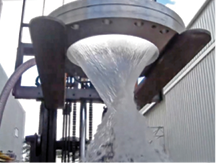Yamana Gold is a Canada-based gold producer with mines and operations in Canada, Mexico, Brazil, Argentina and Chile. Yamana Gold’s Chapada open-pit gold-copper mine in Brazil is a relatively low-cost operation and contributes significantly to Yamana’s favorable cost structure.

A session with Outotec’s online FloatForce value calculator to estimate the potential return of investment (ROI) of a flotation retrofit project prompted Yamana Gold to choose Outotec for a turnkey flotation-plant upgrade.
In 2015, Finnish process-technology provider Outotec delivered a Courier on-stream analyzer to the mine, which enabled operators to determine they were losing a significant amount of metal content to tailings. The mine’s flotation circuit also suffered from poor availability caused by heavy sanding of the flotation cells.
Yamana was looking for a partner to improve its operations. Daniel Diez, responsible for Yamana Gold’s business and operations development in South America, along with the entire site processing team, researched various approaches to boost flotation circuit performance, and invited Outotec to jointly develop a solution to solve the mine’s processing challenges.
“Outotec developed a concept [targeted] to minimize the shutdown period, which [took] the total cost of the project and the return of investment into consideration. With this concept and the full solution including demolition, installation and commissioning and shutdown process know-how, Outotec offered the added value to the customer and won the project,” said André Batista, sales director, Outotec Brazil.
In March, Outotec began replacing 10 existing 160-m3 non-Outotec flotation cells with new units representing its TankCell and FloatForce technology. The project scope included Computational Fluid Dynamics (CFD) studies, basic and detailed engineering, shutdown planning, delivery of proprietary equipment, turnkey installation, commissioning, assisted operation, and advanced training of site personnel. Outotec’s manufacturing and service workshop in Guarapari, Brazil, supported the project.
At the start of the project, Outotec completed an in-depth metallurgical assessment of the rougher/scavenger flotation circuit and identified a large potential for improvement in the flotation plant, which could positively impact overall copper and gold recoveries. An on-site mechanical assessment with advanced laser 3-D scanning collected the necessary technical information for shutdown and installation planning.
During the course of the project, Outotec manufactured custom-made steelworks in Brazil and imported only specialized items; handled logistics, disassembly and removal of old equipment; conducted installation and mechanical completion of new cells; implemented all commissioning phases; and started up and tested the flotation cells jointly with Yamana personnel. In total, more than 80 Outotec personnel implemented the modernization in day and night shifts.
The shutdown required for cell replacement took place in two phases—affecting just one line of five flotation cells at a time and allowing plant processing to continue with half the equipment operational at all times. With the experience gained from the first-phase installation, Outotec took only six days to install the second bank instead of the planned 11 days.
The company reported that the upgrade has provided improved stability and control of the plant’s flotation cells, enabling greater process optimization; and the new cells have reduced energy consumption by 40%. Overall, the reduction of cell sanding has increased flotation circuit availability, leading to higher production and improved recovery of both copper and gold.
Technology Makes Slurry Pumping Less of a Drag
Australia’s CSIRO has developed what it described as a “water and energy efficient technology for reducing the problematic drag effect” experienced in pipes during industrial pumping. The system has been implemented by Glencore’s Minara Resources, and is touted as capable of saving companies millions of dollars each year.
As CSIRO pointed out, almost all mineral processing plants need to transport slurry through pumps at various process steps. A thick slurry is prone to friction or a “drag effect” in the pipes, making it more energy and capital-intensive to pump, as well as susceptible to blockages. To overcome this, water is added to dilute the slurry, but this has the drawback of lowering the ore throughput achieved.
To overcome this problem, CSIRO developed a new technology that takes the energy-sapping drag out of industrial pumping. It introduces a thin, uniform and durable ring of fluid between the slurry and the inside of the pipe so that thick material can be efficiently pumped without friction at a high throughput.

The technology introduces a thin ring of fluid between slurry and the pipe interior surface, allowing efficient pumping without friction.
The technology was first trialed by by nickel producer Minara when their feed ore slurry pumping systems began overloading as they steadily increased their ore throughput. The company’s initial response was to operate both the duty and stand-by pumps in parallel; however, this quickly became constrained. The alternative of further diluting the slurry was not an option because it would reduce metal recovery and negatively affect reagent use in the downstream process.
CSIRO said it worked with Minara Resources to initially identify a low-cost installation point with good potential for addressing the challenge. Installing the drag reduction technology provided a 20% reduction in pressure to free up capacity in their slurry pumping system.
Minara Resources has since adopted the drag reduction technology at its Murrin Murrin nickel operation. Implementation allowed the company to avoid an expensive upgrade to its existing plant to meet throughput demand.
CSIRO said it believes the technology can save mining companies millions of dollars on energy and water use each year, while boosting their productivity. It conceivably could be applied to a broader range of industrial processes where there’s a dewatering aspect that results in a sludge, slurry or paste that needs to be transported.
For mining, the technology allows variations in the ore’s viscosity or water content to be easily managed.
MultiLoad Slate Offers a New Take on Tracking Fluid
Toptech Systems, a provider of bulk terminal automation hardware and software, released a new product called MultiLoad Slate. According to Florida, USA-based Toptech, Slate now offers the benefits of the popular MultiLoad II batch control meter register to virtually every sector involved in the movement of fluids, including mining. As a flexible flow controller, Slate uses each customer’s information to provide a solution specific to its needs.
Toptech says that companies have traditionally had only a few options for their fluid transfer tracking needs, such as the slow, manual process of tracking transactions with pen, paper and a spreadsheet. This leaves them with only a best estimate of how much product moved each month and requires hours of data entry for accounting. Another option has been to use a standardized automation system. Since these systems aren’t industry-specific, they may include unneeded features or use unfamiliar terminology. A third option has been to build a custom automation system. This requires a significant investment of time and money. In addition, the company must pay for more customization every time it changes a process.
MultiLoad Slate is designed to help companies with any type of fluid loading and offloading application. This device, explains Toptech, stores information the company needs before a transaction begins, tracks every transaction, and sends it to the user’s software system for a fraction of the cost of PLC/PC-based solutions.
Application-specific databases can be stored in the device, allowing it to speak the language of any industry. In addition, Slate supports custom prompting, allowing companies to choose the level of security and information they require before each load. Slate includes a full alphanumeric keypad and a color display. It is also Division I or II certified.









